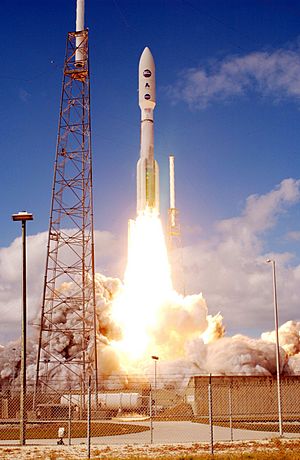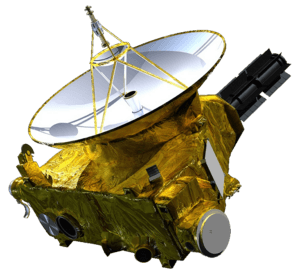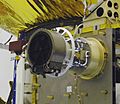New Horizons facts for kids
The New Horizons spacecraft is a special robot sent into space by NASA. It was launched on January 19, 2006. Its main goal was to fly past the dwarf planet Pluto. It was the first spacecraft ever to visit Pluto.
New Horizons traveled for nine years to reach Pluto. It arrived at the Pluto-Charon system on July 14, 2015. As it flew by, it took many amazing photos and collected important information. It took about 15 months to send all this data back to Earth.
New Horizons also set a record! It was the fastest object ever launched from Earth. It got a speed boost from Jupiter using something called a gravity assist. This helped it travel very fast without using too much fuel.
Contents
What New Horizons Carries
The New Horizons spacecraft has several cool tools on board. These tools help it study planets and space.
- LORRI: This is a powerful camera that takes long-range pictures.
- Ralph: This is a telescope and a color camera. It helps see details and colors.
- Alice: This tool studies ultraviolet light. It helps scientists learn about atmospheres.
- Particle Spectrometer Suite: This set of tools studies the solar wind and tiny particles in space.
- VBSDC: This is a special counter that measures dust in space. Students helped design it!
- REX: This tool uses radio waves to study atmospheres and surfaces.
Missions of New Horizons
New Horizons has two main missions.
Studying Pluto and its Moons
The first and most important mission was to study Pluto and its moons. Scientists wanted to learn about their surfaces, atmospheres, and how they formed. New Horizons sent back incredible images and data that changed what we knew about Pluto.
Exploring the Kuiper Belt
The second mission was to explore the Kuiper Belt. This is a huge area beyond Neptune filled with icy objects. If New Horizons could fly past another object there, it would study it.
On January 1, 2019, New Horizons successfully flew past a small Kuiper Belt object. This object is called 486958 Arrokoth. It was also known as 2014 MU69 and nicknamed "Ultima Thule." This was the farthest object ever explored by a spacecraft!
New Horizons still has some fuel left. Scientists hope to find another object for it to fly past. It continues to send back information about its journey through deep space.
Images for kids
-
Artist's impression of New Horizons' close encounter with the Plutonian system
-
View of Mission Operations at the Applied Physics Laboratory in Laurel, Maryland (July 14, 2015)
-
New Horizons in a factory at Kennedy Space Center in 2005
-
New Horizons' RTG
-
New Horizons' antenna, with some test equipment attached.
See also
 In Spanish: New Horizons para niños
In Spanish: New Horizons para niños





















